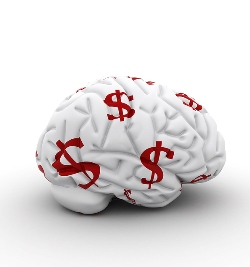 Many people believe that a little “retail therapy” is just the ticket for times when they are feeling down or stressed. We all like to get something new once in a while, but for some, the self-pity purchase is made too frequently. If you are one of those people, it might help to know that researchers have identified a part of the brain that can determine whether you are good or bad with money. It goes to the very heart of self-control, and allows us to understand why some people are extremely self-disciplined; while others, not so much. Brain chemistry can actually play a huge role in your financial habits.
Many people believe that a little “retail therapy” is just the ticket for times when they are feeling down or stressed. We all like to get something new once in a while, but for some, the self-pity purchase is made too frequently. If you are one of those people, it might help to know that researchers have identified a part of the brain that can determine whether you are good or bad with money. It goes to the very heart of self-control, and allows us to understand why some people are extremely self-disciplined; while others, not so much. Brain chemistry can actually play a huge role in your financial habits.
In a study published in the Journal of Consumer Research, a small part of the brain called the insula was scanned as participants pretended to make buying decisions. The insula is critical to understanding what it feels like to be human. According to neuroscientists, it is the starting point for many emotions, including guilt. A strong insula enables some consumers to stop before they make a purchase; even if it means leaving their goods right at the cash register. It can be a strong predictor of purchasing decisions—the insula acts as a “neural tightwad” that anticipates the pain of payment right before one makes a purchase. The more active someone’s insula is, the less likely they will be to shell out extra bucks for a new purse, shoes, or golf clubs.
Intellectually, we all know better. But in reality, we splurge instead of saving for retirement. We carry high balances on credit cards instead of paying down debt. We buy lottery tickets knowing we have a less-than-miniscule chance of winning. Something else has to be adding undue influence and/or undermining our decision-making process. Using MRI machines to track blood flow, researchers can see that in matters of money, the human brain is of two minds. One is rational, the other emotional.
The field of neuro-economics is a new science that investigates brain circuitry and the financial choices people make. Highly respected business schools across North America now offer courses on the subject. It is controversial because it competes with long-held economic theory that believes consumers are rational human beings who use logic, not emotion, to make decisions. But neuro-economics has turned that traditional thinking upside down.
In layman’s terms, the pain and pleasure centers of your brain are “duking” it out when you decide whether or not to spend money. In the moment, you make your spending decision based on whether the pain or pleasure center has the stronger influence. But HOW you decide to pay for an item can also influence the decision. If you are going to pay for your purchase in cash, you feel the pain immediately, and are much more likely to put the item down and walk away. However, if you use credit, you are delaying the pain, so purchasing feels less like a punishment and more like gratification. We actually unbalance our brain’s natural “help” chemistry when we pay with credit.
One of the downsides to this new understanding of the brain is that retailers, marketers, and advertisers now have access to the same information as neuro-scientists and economists. They will want to use this knowledge to sway your brain chemistry. They already know they can increase your “pleasure core” by playing music, having helpful sales clerks, and giving you extra savings if you use your store credit card. Five years ago, no one was using the brain’s emotional core as a factor in financial decision-making. Now we have to worry about the subliminal influences as well as the temptation of the product itself. And you thought you had your holiday shopping all figured out!!
Writer:
Donna Green, Extension Educator, Family and Consumer Sciences, Ohio State University Extension, Erie County. Erie Basin EERA. green.308@osu.edu
Reviewer:
Liz Smith, M.S, RDN., L.D. NE Regional Program Specialist, SNAP-ED, Ohio State University Extension
References:
http://phys.org/news197735312.html
http://www.ncbi.nlm.nih.gov/pubmed/23000783
http://www.statisticbrain.com/what-consumers-spend-each-month/
http://webuser.bus.umich.edu/srick/Globe%20and%20Mail%204-27-07.pdf
http://news.stanford.edu/news/2005/september28/neuron-092805.html

